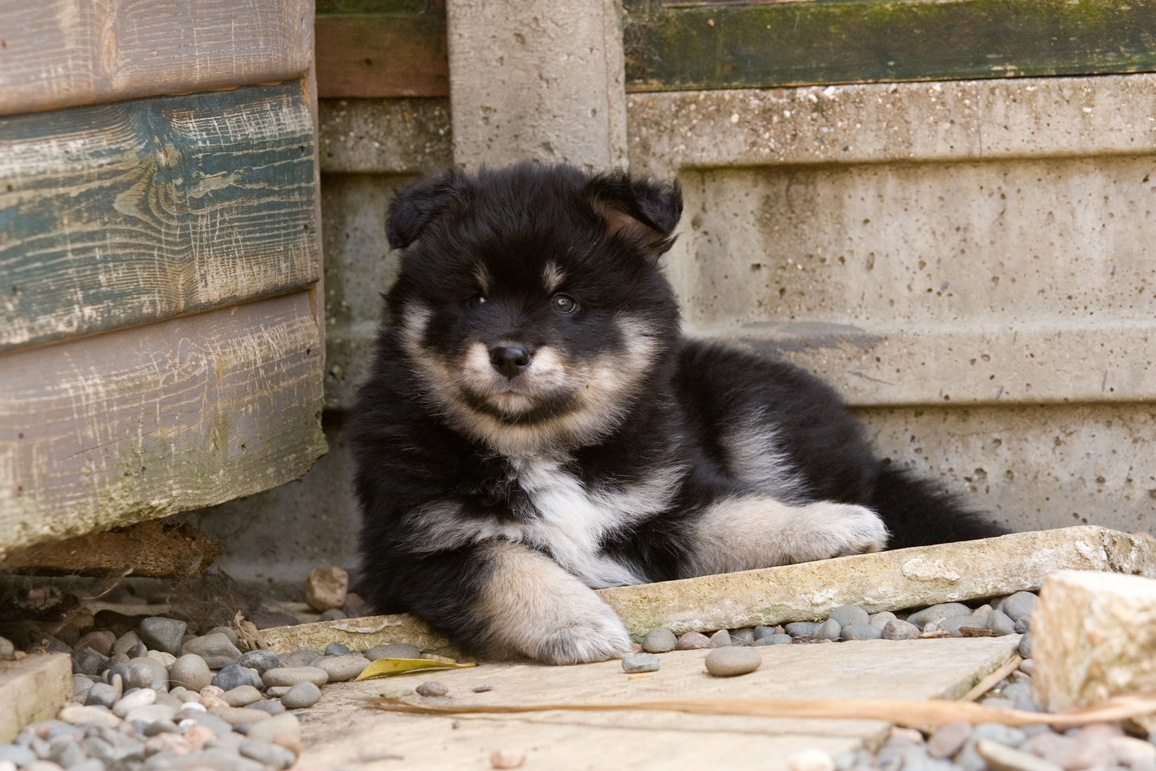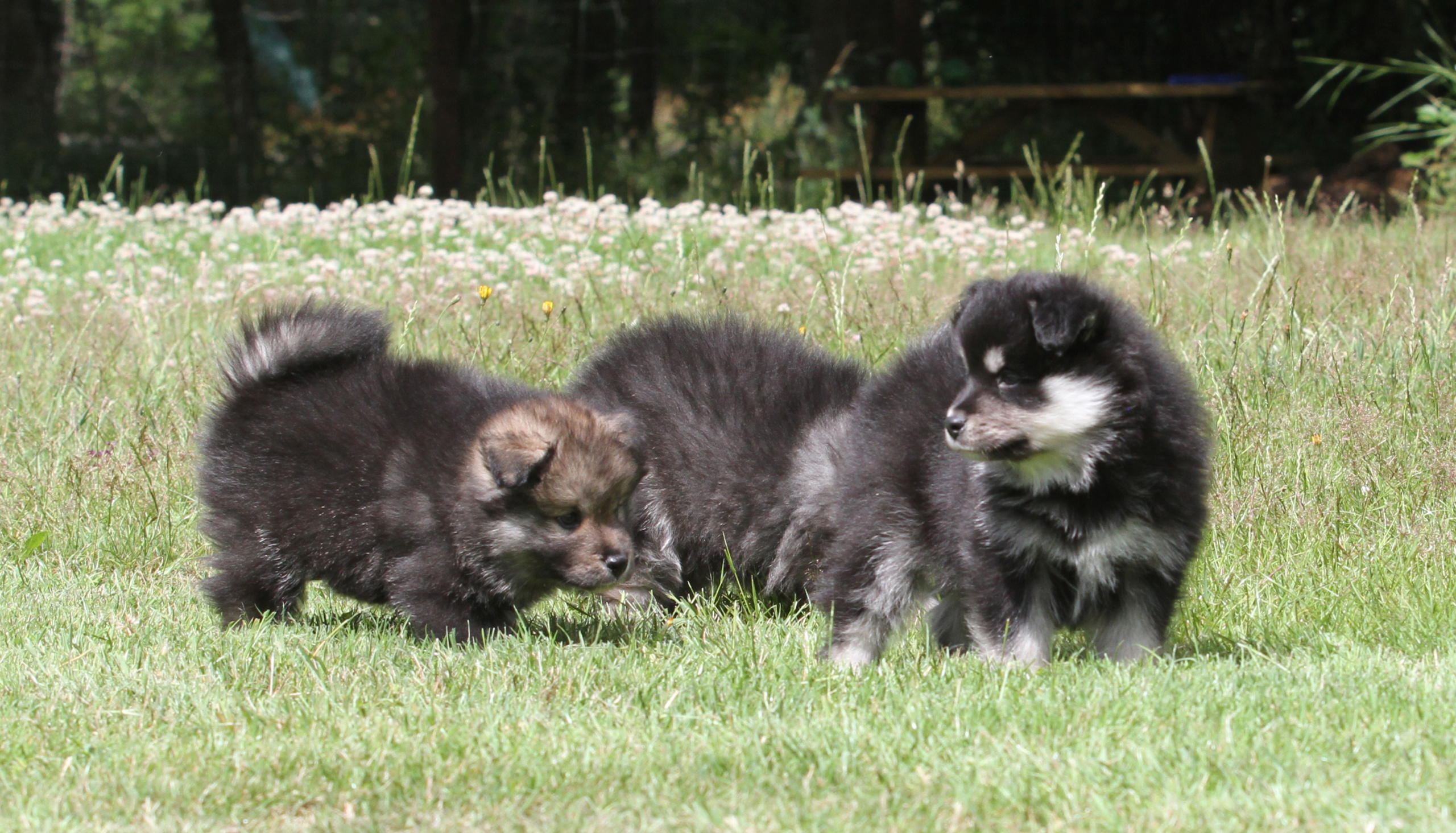Finnish lapphunds are still a relatively rare breed in the UK (at time of writing just over 1200 puppies have been born since 1992 – 2020), but their popularity continues to grow as people see them out and about. As a breed you cannot fail to be attracted by the Finnish Lapphund’s stunning looks, but you must find out if this busy, intelligent and often dependent breed is suitable for you. There are relatively few breeders of Finnish Lapphunds, and so you are advised to make contact with a number and find out how committed they are to the breed and you as a potential owner before deciding where to purchase a puppy. Remember buying a puppy should never be done on a whim, and luckily Finnish Lapphunds are rarely available off the shelf, as most responsible breeders will have extensive waiting lists.
Most definitely, my Lapphunds live as our house pets, sharing their affection between myself, Stuart and Phillip. Personally I do not think they are happy as kennel dogs – they are a very social breed and like to be very much part of the family. They are very affectionate and love all people, irrespective of age, though of course no dog should be left unsupervised with young children.
What is important, is to make sure that you get your puppy from a well-socialised litter, and from parents whose temperament suits your lifestyle, responsible breeders will get to understand you and your family, and will suggest which puppy has a temperament to compliment your family life. In my experience pups born into a home environment (rather than kennel) tend to be better socialised, used to noises and people etc
-
Remember FLs are a working breed and their temperaments may tend to wards strong herding instincts, as an intelligent breed they require a fair degree of mental stimulation for their sanity.
They are best suited to active, fun loving families.
FLs are not for the couch potato, yes they are a working dog, and physical exercise is necessary to their healthy well being. I would guess that on average my dogs get a minimum of 1 hour of free running a day, but they can, and do take a lot more if offered, enjoying a run along side the mountain bikes etc.
But what is probably more important is the quality of the mental stimulation that they receive in addition to the physical stimulation. The FL has a very clever and active brain, and soon becomes bored, especially when young. You must consider the dog’s emotional/mental needs, like training for obedience, agility flyball etc. Teaching tricks and playing special games.
To many of us, this is a preference that you can only express if you have had both sexes, and then you find that you may bond better to one sex or the other. What is often meant by this question for pet owners, is either of the sexes easier to live with? Whilst the FL male can be rather dominant with other lapphund males, they are usually fine with other breeds if socialised properly. In my experience the males and females are equally trainable. For those of us experienced with living with both – we would probably say the males are more chilled and affectionate at home, though of course each is an individual.
Of course the males tend to be a little larger and have more coat than bitches, but the breed standard allows for an overlap in the size between the two sexes – so a small male could be same size as a large female.
Of course with bitches you will need to consider whether to spay (neuter) or not; the bitches seasons (up to twice a year) can be inconvenient, messy and may produce temperament changes in the bitch as she undergoes hormonal influences. Many would advise to have bitches neutered – though I am against early neutering (my personal preference is once the bitch is fully matured around 18 months – and the timing is preferably about 3 months after a season/heat).
Although the breed has a very attractive and heavy coat, it will surprise many to hear that they require only a small amount of grooming (about 0.5 hour a week should be adequate.). The main areas on which to concentrate being around the ears, and the tail and long feather on the legs and under the tail. No trimming is required (and this should be emphasised if using a grooming parlour, as they can get over zealous with scissors, likewise they should be told NOT to remove the undercoat as this protects the dogs from cold and heat). Some owners may prefer to trim under the pads to reduced the amount of mud bought into the house!
Depends if you let them!
In my experience no.
The breed is very trainable, and my dogs have all been taught that barking is not a behaviour that I accept. However the FL can be very vocal, and if not trained correctly they will use their voice to get attention, it is important to realise when you have a puppy not to positively reward any noisy behaviour.
Remember some breeds like to get their way and and lapphunds being intelligent will quickly realise if you are reacting to it when it makes a noise, and a reaction be it shouting back or using a toy/treat to divert attention could be perceived by your excitable puppy as a reward. Thus encouraging it to bark again!
In my opinion the answer to this is NO.
It is a complete fallacy that a bitch must have a litter. Producing a healthy litter of pups is not easy and many things need to be considered when selecting suitable sires, plus there are the difficulties in ensuring suitable homes can be found for the pups, and can you offer a lifetime of support, or take a puppy/adult back should they be returned to you?
Without wishing to sound pompous the breeding is often best left to the ‘experts’.
The breed as a whole is healthy & robust and the life expectancy is around 12-14 years of age, and 16-17 years is not uncommon.
Information on the genetic conditions known to affect the breed can be found on the health page.
Whilst my own dogs do not live with cats, I would say that the majority of Finnish Lapphunds do, and its the cats that rue the roost!
If you want photographic proof, check out these delightful photos from Pia, showing Elbereth Jalo at Arktinen & Elbereth Kaisa at Arktinen with their cats
The breed comes in a diverse range of colours, from cream/biscuit colour to solid black. The most common colour in the breed is the black & tan, sometime with white markings. But all colours are equally acceptable, and choice of colour is a personal preference. What is important is that the breed standard states that the main colour must cover the majority of the dog, so parti colours as often seen in spitz breeds are not permitted in the Finnish Lapphund.
Given any colour is acceptable and in my opinion when breeding you should breed together the best dog and bitch in respect of breed attributes, temperament and health, colour is never something that should be considered as a target by a breeder, however some breeders do find pleasure in breeding less common colours and will arrange their matings simply to achieve a wide spectrum of rainbow colours, sadly this results in dogs that display less and less attributes which make the breed what it is. One key element that quickly changes when selecting away from the darker colours is eye colour, the breed should have a soft expression partially created by the dark brown eye colour which is called from in the breed standard, if breeders work towards paler colours then eye colour quickly changes and the dogs have a harsh staring expression.
The breed is still quite rare in the UK (only about 50-75 puppies are born a year), the breed having been first introduced into the UK in 1989. Breeders are careful to breed for quality and not quantity, and with litter sizes being on average about five pups, the numbers are rising slowly. The Southern Finnish Lapphund Society maintain a puppy list, and they should be able to advise on puppy availability. Or contact us and we will be happy to put you in touch with breeders in your area.
Remember as the slogan say “A puppy is for life not just for Christmas/COVID”, it is better if puppies are not simply available off the shelf to be purchased on a whim, but something to aspire to, hopefully a puppy will be with you for 14 or so years, so your decision should not be taken lightly. Waiting for a puppy gives you time to prepare and learn about the breed and build up a relationship with your breeder.
I am often asked about puppy prices here in UK, I do hear tales of astronomical prices and loan agreements – generally 2020 prices are around £1500 – if breeders are inflating this due to COVID then I’d seriously reconsider the motives of your breeder.
You may think it easier/cheaper to get your puppy from Finland – just remember, the UK import rules mean your puppy will be at least 16 weeks old before can enter UK, plus there are pretty hefty costs to fly a puppy into UK, and import requirements to meet. You should also consider the environment in which a puppy would be living in these early informative weeks.
They are much more independent than BCs, so can be inclined to go hunting when let off lead, BUT they are very food motivated, so if trained well, they can be just as good as BCs, like BCs they are herders, so care needs to be given where livestock are concerned.
Finnish Lapphunds have been trained as support dogs for both Dogs for Disabled & Hearing Dogs for the Deaf, they can also be successful in Rally, agility and Obedience.
Ask Us
Please feel free to drop us a line to ask about the breed and its suitability, we are more than happy to welcome visitors to meet the dogs and talk through the quirks.
Better you find out before buying a puppy if they are suitable for you, than after!
Still Need Help?
Other useful resources
The SFLS offers advice and ways to meet the breed, you can also join them on the SFLS facebook page
The Finnish Lapphund facebook page is a great way to ask a lot of owners a question
Champdogs also has a list of breeders






